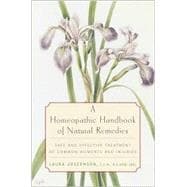
| Acknowledgments | |
| Introduction | |
| How to Use this Book | |
| What is Homeopathy and How Does it Work? | p. 1 |
| History and Guiding Principles | p. 3 |
| A Homeopathic View of Health and Disease | p. 12 |
| Putting Homeopathy Into Practice | p. 19 |
| Taking the Case | p. 21 |
| Reviewing the Findings and Selecting the Remedy | p. 28 |
| Selecting the Potency and Dosage | p. 31 |
| Assessing the Response | p. 35 |
| What to Avoid | p. 37 |
| Administering the Remedy | p. 40 |
| Being Prepared: Stocking and Storing Your Home Kit | p. 42 |
| Homeopathic First Aid | p. 51 |
| Dosage and Potency for First Aid | p. 55 |
| First Aid Conditions | p. 57 |
| Acute Ailments and Their Treatment | p. 93 |
| Childhood Conditions | p. 195 |
| Materia Medica: Descriptions of the Major Remedies | p. 227 |
| List of Remedies | p. 277 |
| Glossary | p. 281 |
| Suggested Readings | p. 285 |
| Bibliography | p. 289 |
| Resources Directory | p. 291 |
| Index | p. 301 |
| Table of Contents provided by Blackwell. All Rights Reserved. |
The New copy of this book will include any supplemental materials advertised. Please check the title of the book to determine if it should include any access cards, study guides, lab manuals, CDs, etc.
The Used, Rental and eBook copies of this book are not guaranteed to include any supplemental materials. Typically, only the book itself is included. This is true even if the title states it includes any access cards, study guides, lab manuals, CDs, etc.
Excerpted from A Homeopathic Handbook of Natural Remedies: Safe and Effective Treatment of Common Ailments and Injuries by Laura Josephson
All rights reserved by the original copyright owners. Excerpts are provided for display purposes only and may not be reproduced, reprinted or distributed without the written permission of the publisher.